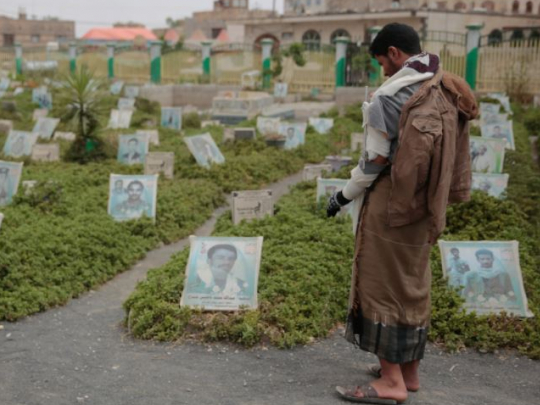Saudi Coalition Withdrawal from Hodeidah Raises Hopes Yemen War May Be Coming to an End

In the latest strategic blow to the Saudi-led Coalition in Yemen, forces from the United Arab Emirates (UAE) have withdrawn from three strategic directorates in southern Hodeidah, Yemen’s main entry point. The withdrawal comes on the heels of Ansar Allah’s recent capture of the oil-rich Marib province, the Saudi-backed government’s last northern stronghold.
The withdrawal constitutes an important turning point for Ansar Allah-led forces, as the coastal areas (al-Durayhimi, al-Tahieta, Bait al-Faqieh) act as a gateway not only to recapture the strategic Mocha Port on the country’s southwestern coast but also to Bab al-Mandab, a vital strategic link in maritime trade routes between the Mediterranean Sea and Indian Ocean.
In the wake of the withdrawal, the Joint Military Heterogeneous Forces — made up of rival local militant groups led by the UAE — issued a statement claiming that they “had redeployed troops away from Hodeidah because there was a ceasefire deal in place there since 2018,” adding, “the joint forces recognized the mistake of remaining in defensive barricades, unable to fight under an international pact, while various front lines require support.” That agreement did not stipulate withdrawal to the city of Mocha, which lies nearly 110 kilometers from Hodeidah.
The Saudi-backed government of President Abdul Mansour al-Hadi, who invited the coalition to intervene in Yemen, criticized the move and said it was given no advanced notice of the withdrawal. Commanders of Saudi-allied militant groups in southern Hodeidah — including the Giants Brigade, which is composed of Salafi militants who have been fighting on behalf of Saudi Arabia and UAE in Yemen since 2017 — said that the unilateral decision to withdraw was shocking and surprising and made without their consultation. The move was also met with anger by the Tareq Salih Forces, and the so-called Tuhami Resistance, as well as other Saudi coalition-allied militant groups. The United Arab Emirates has recruited thousands of Yemeni youth into various armed militant groups, including ISIS and Al-Qaeda, in a bid to occupy Yemen’s strategic coastline.
The UN mission that was tasked with observing the 2018 ceasefire deal confirmed the recent withdrawal. Fighting erupted in Hodeidah in mid-2018 after the Saudi-led Coalition moved in to wrest control of Yemen`s strategic port from the Ansar Allah-backed Yemen Army. After months of deadly clashes, both sides agreed to a ceasefire. In fact, the agreement – once seen as an important first step in ending the conflict – was never fully implemented, with the Yemeni Army accusing the Saudi-led Coalition of repeatedly violating the 2018 deal.
Signs the war may finally be winding down
In another sign that the highly unpopular war may be nearing its conclusion, a large contingent of Saudi troops stationed in the Buraiqeh district along the northern coast of the Gulf of Aden has withdrawn from Aden, the self-declared capital of the Saudi-backed Yemeni government. Troops were moved out of the city via sea and air amid tight security measures that included the closure of a number of roads, according to local sources. As it has done in the past, the Saudi Coalition insists that the move is not a withdrawal, but is instead a strategic redeployment. It is not yet clear where the large contingent of Saudi troops and armored vehicles were transferred to.
The collapse and mass retreat of Saudi-led forces on the Yemen coast has already precipitated the advance of Ansar Allah across the south of the province. The three strategic directorates were captured by Sana’a forces with little effort. In desperation, Saudi warplanes launched dozens of airstrikes on the areas, killing and injuring countless civilians who had gathered to celebrate the withdrawal of the Saudi-led Coalition and lined the streets to greet what they view as the liberating forces of Ansar Allah.
Warning | Graphic Content
Footage obtained by MintPress News shows charred bodies and burned-out vehicles in the aftermath of Saudi-led airstrikes in a populated area east of Heis in Hodeidah on Sunday.
That warm reception came as no surprise for many in Yemen. As in other areas, people in coastal cities were suffering from the militarization of their regions and villages and serious humanitarian crises alike, thanks in large part to both Saudi and UAE policies. In addition to massive destruction levied on their region by Saudi-led bombing campaigns, the area has suffered from currency issues, high prices of food and medicine thanks to the near-total air and sea blockade, the spread of epidemics, and frequent power outages that have made the coastal cities one of the hardest-hit areas of the war-torn country.
It is not clear whether the Saudi-led Coalition’s withdrawals from Hodeidah and Aden are linked to the battles resulting in their loss of the oil-rich Marib province. However, Yemeni military analysts who spoke to MintPress see the move as a tactic to reposition fighters to Marib in a last-ditch effort to take back the oil-rich province and free up fighters needed to militarize the Red Sea and the Bab al-Mandab Strait.
The Saudi-led Coalition has been working with Israel to secure the important waterway and the recent withdrawal took place in the wake of joint maneuvers in the Red Sea among the United States, Israel, the UAE and Bahrain. The maneuvers, which began last Wednesday, are part of a naval exercise led by the U.S. Naval Forces Central Command (NAVCENT). They represent the first publicly acknowledged naval exercise between the United States, Israel, and the two Gulf countries and are aimed to “face Iran and its regional proxies” as well as to “help safeguard freedom of navigation and the free flow of trade, which are essential to regional security and stability,” according to Washington and Tel Aviv.
- Source : Ahmed Abdulkareem - Mintpress News


















